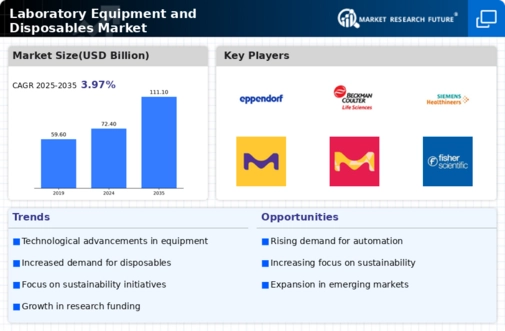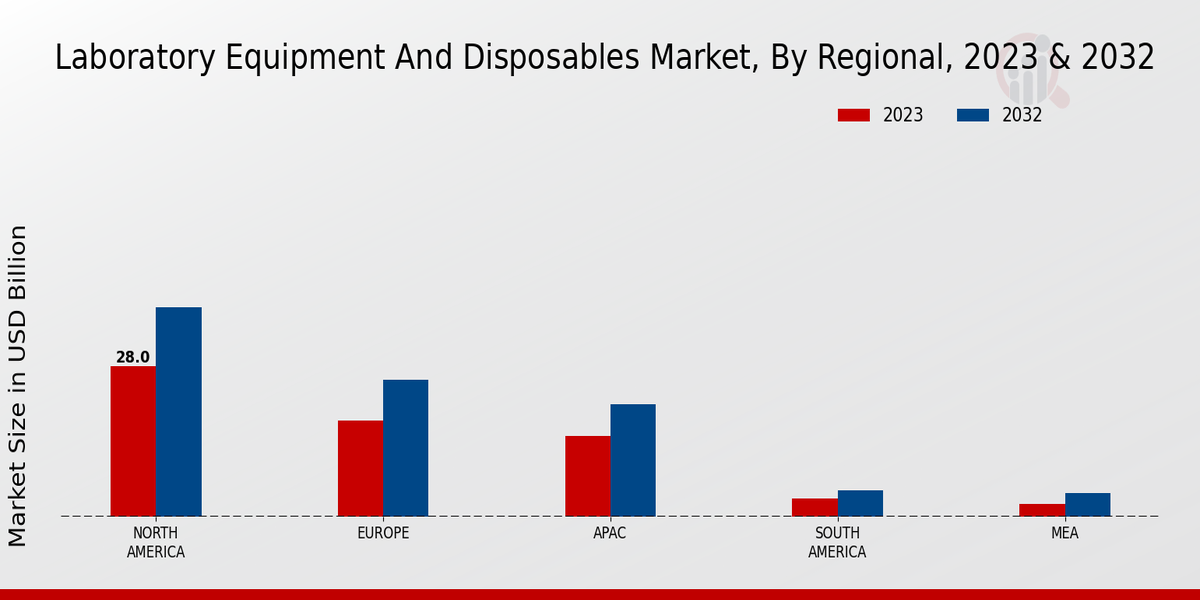Market Growth Projections
The Global Laboratory Equipment and Disposables Market Industry is projected to experience substantial growth over the coming years. With a market value anticipated to reach 72.4 USD Billion in 2024 and further expand to 111.1 USD Billion by 2035, the industry is on a promising trajectory. The compound annual growth rate of 3.97% from 2025 to 2035 indicates a steady increase in demand for laboratory equipment and disposables. This growth is driven by various factors, including technological advancements, rising healthcare expenditure, and an expanding focus on research and development. The market's positive outlook suggests a robust future for laboratory equipment and disposables.
Rising Healthcare Expenditure
Healthcare expenditure continues to rise globally, significantly impacting the Global Laboratory Equipment and Disposables Market Industry. Governments and private sectors are investing heavily in healthcare infrastructure, which includes laboratories. This investment is crucial for improving diagnostic capabilities and research initiatives. For example, countries are allocating substantial budgets for laboratory upgrades and new equipment procurement. This trend is expected to contribute to the market's growth, with projections indicating a market value of 111.1 USD Billion by 2035. The increased funding for healthcare is likely to enhance laboratory operations, thereby driving demand for various laboratory equipment and disposables.
Increasing Demand for Advanced Research
The Global Laboratory Equipment and Disposables Market Industry experiences a notable surge in demand for advanced research tools and technologies. This trend is primarily driven by the growing need for precision and accuracy in laboratory settings. For instance, the rise in biotechnology and pharmaceutical research necessitates sophisticated equipment such as high-throughput screening systems and automated liquid handling devices. As a result, the market is projected to reach 72.4 USD Billion in 2024, reflecting an increasing investment in research and development. This focus on advanced research tools is likely to propel the market further, as organizations seek to enhance their capabilities.
Growing Focus on Environmental Sustainability
The Global Laboratory Equipment and Disposables Market Industry is increasingly influenced by a growing focus on environmental sustainability. Laboratories are under pressure to adopt eco-friendly practices, leading to a demand for sustainable laboratory equipment and disposables. This includes the use of biodegradable materials and energy-efficient devices. For example, many laboratories are transitioning to reusable glassware and sustainable packaging solutions. This shift not only aligns with global sustainability goals but also appeals to environmentally conscious consumers. As laboratories prioritize sustainability, the market is likely to adapt, fostering innovation in eco-friendly products and practices.
Expansion of Research and Development Activities
The expansion of research and development activities across various sectors significantly impacts the Global Laboratory Equipment and Disposables Market Industry. Industries such as pharmaceuticals, biotechnology, and environmental science are increasingly investing in R&D to drive innovation and improve product offerings. This expansion necessitates the procurement of advanced laboratory equipment and disposables to support experimental processes. For instance, the pharmaceutical sector is ramping up its research efforts to develop new drugs and therapies, thereby increasing the demand for laboratory tools. This trend is expected to sustain market growth, as R&D activities continue to flourish globally.
Technological Advancements in Laboratory Equipment
Technological advancements play a pivotal role in shaping the Global Laboratory Equipment and Disposables Market Industry. Innovations such as automation, artificial intelligence, and data analytics are transforming laboratory processes, enhancing efficiency and productivity. For instance, automated systems for sample analysis and data management are becoming increasingly prevalent, allowing laboratories to handle larger volumes of work with greater accuracy. These advancements not only streamline operations but also reduce human error, which is critical in research environments. As laboratories adopt these technologies, the market is expected to witness a compound annual growth rate of 3.97% from 2025 to 2035, indicating a robust growth trajectory.



















